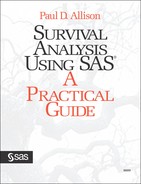Conclusion
The maximum likelihood methods discussed in this chapter are attractive alternatives to partial likelihood when there are many ties and many time-dependent covariates. Not only are they much more computationally efficient, but they also give direct estimates of the effect of time on the hazard of an event. In my experience, novices often have difficulty with both the conceptualization and implementation of time-dependent covariates in PROC PHREG. They easily make mistakes that go unnoticed. By contrast, the methods discussed here have great intuitive appeal and are relatively straightforward to implement. Once the expanded data set is constructed, the analyst can proceed as in an ordinary logit regression analysis with no need to treat time-dependent covariates any differently than fixed covariates. This approach also has advantages whenever there is ambiguity about the time origin. Because time is treated just like any other covariate, there is great flexibility in specifying and testing alternative functional forms, and multiple time scales with different origins can be included in the model.
